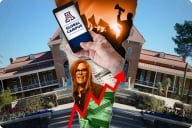You have /5 articles left.
Sign up for a free account or log in.
In the last two years, three employees and two students in the North Dakota University System have been arrested for possession of child pornography -- some of which was downloaded through university networks and onto university-owned computers.
To stop people from accessing this illegal content on campus, the university system earlier this year decided to take action and block access to child-porn sites through its network.
This decision, made as part of a wider Safeguarding UND strategy, went into effect in mid-March.
Rather than ban search terms or use a third-party service provider to filter web content, the system has joined the Internet Watch Foundation -- a nonprofit organization based in Britain that maintains a list of websites known to host content that depicts the sexual abuse of children and works with law enforcement agencies to have material removed.
The North Dakota University System will use the IWF’s list (updated twice daily) to block access to URLs that display pornographic images or videos of children. Though a couple of British universities have joined IWF, the North Dakota system is the first in the U.S. that has done so, an IWF spokeswoman said. Many IWF members are technology companies.
Brad Miller, director of information security at the university system, said that he believed that using the IWF list was the best way to limit what users can see through the university network. Other methods are not as specific and might accidentally block appropriate web content, he said. The university previously did not block any web content, for just this reason.
Finding a method that would not hinder academics doing legitimate research was a priority for the university, said Miller. He noted that as the IWF only lists webpages that contain illegal videos and pictures, it is highly unlikely that academics would need to gain access to these sites. However, if necessary, administrators will be able to grant access on a case-by-case basis. Miller said faculty have been informed of the changes and instructed on how to obtain exceptions if necessary.
When someone tries to access a blocked site on campus, a message will appear explaining why the content they are trying to access is blocked. A log of these events will be monitored by university staff, who may report repeated incidents to the police.
The system, though stricter than anything the university system has put in place before, is not fail-safe, said Miller. It is possible to get around the blocks by disguising a computer’s IP address. There is also nothing to stop faculty, students or staff from accessing content at home.
Anna Borgström, director of NetClean -- a company that provides technology solutions to fight child sexual abuse -- said that it is common for people who view child porn on work computers to use anonymization services to disguise their IP addresses. She said it is also common for people to download content at home onto USB sticks or external hard drives, which they then bring in to work.
Borgström said that one way to get around this issue is to install on university computers software that can identify illegal images, even when a user is off-line. NetClean offers a tool that does this.
Lori Handrahan, a human rights activist and author of Epidemic: America’s Trade in Child Rape, said that her research has shown a “concerning number” of university professors being arrested on child-pornography charges. As of early 2017, Handrahan had identified 115 university professors and staff arrested on child-pornography charges in recent years, though Handrahan said that her research was not comprehensive and the true number is likely much larger. These crimes are frequently committed on campus, said Handrahan, but very few universities have any kind of blocks or filters in place.
Handrahan said she was thrilled to hear that the North Dakota system had signed up with the IWF, and she hopes that other universities will follow suit. But Natasha Tusikov, a sociologist at Brock University in Canada, who has studied internet-governance issues, said that joining the IWF might be a controversial choice for the university. Tusikov said the IWF has excessively censored content in the past, which may concern some researchers. In 2008, for example, the IWF blocked a Wikipedia page showing an album cover with art depicting a nearly naked young girl. The IWF later reversed its decision.
Harriet Lester, technical projects officer at the IWF, said that the organization takes several steps to ensure that content is not “overblocked.” The IWF’s list of URLs often blocks only certain pages within websites, rather than whole websites (unless it is a dedicated child sex abuse site). Additionally, the list is updated twice a day, and links are taken off the list as offending content is removed, said Lester.
Though they are pleased with the news, both Handrahan and Borgström agree that the university system could have gone a step further with their new protections by ensuring that someone from outside the university, such as local law enforcement, is part of the team that reviews whether to report repeat offenders. Otherwise, it would be easy for university administrators to cover for their colleagues, warned Handrahan.
Sharon Wilsnack, Chester Fritz Distinguished Professor in the Department of Psychiatry and Behavioral Science at the University of North Dakota, said that the child-porn block was a "good idea" that was generally supported by faculty members. “I haven’t heard of any opposition,” said Wilsnack.
Wilsnack, who has studied the link between childhood sexual abuse and alcoholism in women, said that it would be unusual for researchers to need access to images or videos of child pornography, but she is confident that the university would not stand in the way of legitimate research.
“I think this is a positive development,” said Wilsnack. “I’m proud of the university for trying these safety measures.”








